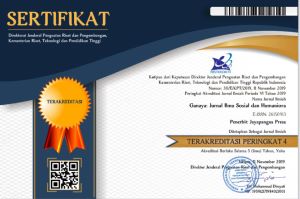Penerapan Ajaran Tri Hita Karana Dalam Tradisi Baris Tengklong di Pura Tambang Badung Kelurahan Pemucutan Denpasar
DOI:
https://doi.org/10.37329/ganaya.v4i4.3095Keywords:
Tri Hita Karana, Tradition, Baris TengklongAbstract
Education is actually a process of inheriting a culture from one generation to the next. Education is defined as the process of changing the attitudes and behavior of a person or group of people in an effort to mature through teaching and training efforts. However, the world of education in Indonesia is not devoid of criticism and rebuke. In addition to the implementation of the education curriculum policy which is still complicated, the high cost of education to the poor quality of Indonesia is still the talk of all Indonesian citizens. But it cannot be denied that the development of digital technology also has a negative impact on the world of education. Excessive use of information technology has proven to have a negative impact on conceptual thinking skills. In response to the above, the author has an assumption that it can be overcome with the concept of Tri Hita Karana. The method used is qualitative research method, which is a type of research that examines and can describe complex and concrete social realities. The application of Tri Hita Karana teachings in the Baris Tengklong tradition at Badung Mine Temple, Pemucutan Village, West Denpasar is a cultural practice that illustrates the harmony and balance between three important aspects of Balinese life, namely human relations with God, human relations with each other, and human relations with nature. Thus, the application of the Tri Hita Karana teachings in the Baris Tengklong tradition at the Badung Mine Temple in Pemucutan Village, West Denpasar, is a clear example of how Balinese culture integrates spiritual, social, and ecological principles to create balance and harmony in their daily lives. This ceremony is a concrete manifestation of Balinese people's lives that pay great attention to harmony in relationships with God, fellow humans, and the surrounding nature. Overall, the application of Tri Hita Karana teachings in the Baris Tengklong tradition at Badung Mine Temple, Pemucutan Village, West Denpasar is a concrete example of how these teachings are still very relevant and alive in the daily lives of Balinese people. It is a manifestation of the way Balinese people try to maintain balance and harmony with nature, gods, and fellow humans in an effort to achieve happiness and prosperity together.References
Cohen, D., & Soto, M. (2007). Growth and human capital: good data, good results. Journal of Economic Growth, 12(1), 51–76. https://doi.org/10.1007/s10887-007-9011-5
Harianti, D. (2021). Internalisasi Ajaran Tri Hita Karana Untuk Anak Usia Dini Pada Masa Pandemi Covid 19: Tri Hita Karana Untuk Anak Usia Dini Pada Masa Pandemi Covid 19. Kamaya: Jurnal Ilmu Agama, 4(3), 264-274.
Kartika, I Made, P. R. A. M. (2021). Membangun Karakter Berlandaskan Tri Hita Karana Dalam Perspektif Kehidupan Global. Jurnal Pendidikan Kewarganegaraan Undiksha, 9(2), 423–430.
Mertala, P. (2019). Digital technologies in early childhood education–a frame analysis of preservice teachers’ perceptions. Early Child Development and Care, 189(8), 1228–1241.
Mulyadi. S., Basuki, H., & Raharjo, W. (2016). Psikologi Pendidikan Dengan Pendekatan Teori-Teori Baru dan Psikologi. Jakarta: Karisma Putra Utama
Nassaji, H. (2015). Qualitative and descriptive research: Data type versus data analysis. Language Teaching Research, 19(2), 129–132.
Permana, I. D. G. D. (2021). the Implication of Tiktok Application As a Media for the Dissemination of Tri Hita Karana’S Teachings During the Covid-19 Pandemic. Vidyottama Sanatana: International Journal of Hindu Science and Religious Studies, 5(1), 128.
Polkinghorne, D. E. (2005). Language and meaning: Data collection in qualitative research. Journal of Counseling Psychology, 52(2), 137–145.
Prince, M. (2004). Does active learning work? A review of the research. Journal of Engineering Education, 93(3), 223–231.
Putrawan, I. N. A., Widnyana, I. M. A., Ekasana, I. M. S., Tus, D. S. A. K., & Vedanti, I. G. A. J. M. (2021). Penerapan Ajaran Tri Hita Karana dalam Penyusunan Awig-Awig Sekaa Teruna Taman Sari di Banjar Lantang Bejuh Desa Adat Sesetan. Jurnal Penelitian Agama Hindu, 5(2), 98-105.
Redi, A., Sitabuana, T. H., Hanifati, F. I., & Arsyad, P. N. K. (2020). The Role of Local Wisdom in Protecting Mangrove Forest in Bali Province.
Saidah. U. H. (2016). Pengantar Pendidikan: Telaah Pendidikan Secara Glogal Dan Rasional. Jakarta: Karisma Puta Utama
Slyusarenko, N., & Zadorozhnya, O. (2021). Usage of Information and Communication Technologies in Maritime Educational Institutions. Proceedings of the International Conference on Economics, Law and Education Research (ELER 2021), 170.
Sugiyono. (2010). Metode Penelitian Pendidikan Pendekatan Kuantitatif, kualitatif, dan R&D. Bandung: Alfabeta
Sukarma, I. W. (2016). Tri Hita Karana: Theoretical Basic of Moral Hindu. International Journal of Linguistics, Literature and Culture, 2(3), 84.
Downloads
Published
How to Cite
Issue
Section
License
Copyright (c) 2021 Putu Surya Andika, Ni Wayan Sariani Binawati (Author)

This work is licensed under a Creative Commons Attribution-ShareAlike 4.0 International License.
An author who publishes in the Ganaya : Jurnal Ilmu Sosial dan Humaniora agrees to the following terms:
- Author retains the copyright and grants the journal the right of first publication of the work simultaneously licensed under the Creative Commons Attribution-ShareAlike 4.0 License that allows others to share the work with an acknowledgement of the work's authorship and initial publication in this journal
- Author is able to enter into separate, additional contractual arrangements for the non-exclusive distribution of the journal's published version of the work (e.g., post it to an institutional repository or publish it in a book) with the acknowledgement of its initial publication in this journal.
- Author is permitted and encouraged to post his/her work online (e.g., in institutional repositories or on their website) prior to and during the submission process, as it can lead to productive exchanges, as well as earlier and greater citation of the published work (See The Effect of Open Access).
Read more about the Creative Commons Attribution-ShareAlike 4.0 Licence here: https://creativecommons.org/licenses/by-sa/4.0/.








